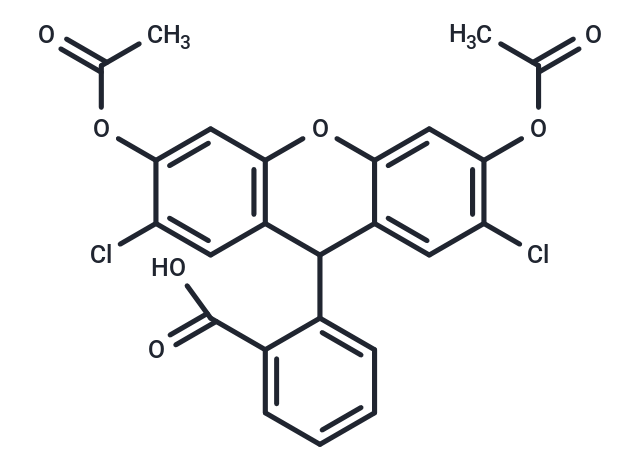Shopping Cart
Remove All Your shopping cart is currently empty
Your shopping cart is currently empty
H2DCFDA (DCFH-DA) belongs to the class of green fluorescent dyes and is a probe for the detection of intracellular reactive oxygen species (ROS) (Ex/Em=488/525 nm) with cell membrane permeability.

| Pack Size | Price | USA Warehouse | Global Warehouse | Quantity |
|---|---|---|---|---|
| 25 mg | $30 | In Stock | In Stock | |
| 50 mg | $37 | In Stock | In Stock | |
| 100 mg | $50 | In Stock | In Stock | |
| 200 mg | $70 | Inquiry | Inquiry | |
| 1 mL x 10 mM (in DMSO) | $30 | In Stock | In Stock |
| Description | H2DCFDA (DCFH-DA) belongs to the class of green fluorescent dyes and is a probe for the detection of intracellular reactive oxygen species (ROS) (Ex/Em=488/525 nm) with cell membrane permeability. |
| In vitro | METHODS: Flow cytometry was used to detect ROS levels: 1, H2DCFDA was dissolved into 10 mM DMSO stock solution and further diluted with PBS before use. 2. Adherent cells are incubated with 5 µM H2DCFDA solution for 30 min at 37°C, protected from light, then harvested with 0.05% trypsin-EDTA solution, suspended in fresh medium and immediately analyzed by flow cytometry (488 nm). [1] METHODS: Confocal microscopy was performed to detect ROS levels: 1. H2DCFDA was dissolved into 10 mM DMSO stock solution and further diluted with PBS before use. 2. Coverslips containing cells were placed in 5 µM H2DCFDA staining solution and incubated for 60 min at 37°C, protected from light, then washed and imaged with a confocal laser scanning microscope Leica TCS SL equipped with an argon laser. [1] |
| In vivo | METHODS: Fluorescence microscopy was used to analyze the oxidative activity of LPS induced peritonitis in mice: 1, H2DCFDA was dissolved in 100 µL ethanol and further diluted with PBS before use. 2. C57BL/6J mice were injected intraperitoneally with LPS (0.1-1 mg/mL) to induce peritonitis. 3.5 h later, H2DCFDA (0.1-0.8 mg/ml) was injected intraperitoneally. 3. 30 min after H2DCFDA injection, the animals were killed by cervical dislocation, and the peritoneal cells were recovered by rinsing with 5 mL of ice-cold HBSS solution at pH 7.4. 4. Peritoneal cells were washed and resuspended in PBS. Macrophages were removed by adhesion method after incubation in a polystyrene dish at 37℃ for 30 min. The supernatant was recovered and approximately 20,000-25,000 leukocytes were added to microscope slides using a cytocentrifuge. The slides were then analyzed using fluorescence microscopy. [2] |
| Cell Research | Instructions: I. Solution preparation 1. Prepare storage solution: Prepare 10 mM H2DCFDA stock solution with DMSO. Note: It is recommended to store H2DCFDA storage solution at -20 ℃ or -80 ℃ in the dark after aliquoting. 2. Preparation of working solution: Dilute the storage solution with preheated serum-free cell culture medium or PBS to prepare 1-10 μM H2DCFDA working solution. Note: Please adjust the concentration of H2DCFDA working solution according to actual conditions and prepare it before use. II. Cell staining (suspended cells) 1. Collect cells by centrifugation and wash twice with PBS for 5 minutes each. The cell density is 1×10^6/mL. 2. Add 1 mL of dye working solution and incubate at room temperature for 5-30 minutes. 3. Centrifuge at 400 g for 3-4 minutes and discard the supernatant. 4. Add PBS to wash the cells twice, 5 minutes each time. 5. Resuspend the cells with 1 mL serum-free medium or PBS, and observe using a fluorescence microscope or flow cytometer. III. Cell staining (adherent cells) 1. Culture the adherent cells on a sterile coverslip. 2. Remove the coverslip from the culture medium and remove the excess culture medium. 3. Add 100 μL of dye working solution, gently shake to completely cover the cells, and incubate for 5-30 minutes. 4. Aspirate the dye working solution, wash 2-3 times with culture medium, 5 minutes each time, and observe using a fluorescence microscope or flow cytometer. Note: If flow cytometry is required, the cells need to be digested with trypsin and resuspended before staining. |
| Synonyms | DCFH-DA, 2',7'-Dichlorodihydrofluorescein diacetate |
| Molecular Weight | 487.29 |
| Formula | C24H16Cl2O7 |
| Cas No. | 4091-99-0 |
| Smiles | CC(=O)Oc1cc2Oc3cc(OC(C)=O)c(Cl)cc3C(c2cc1Cl)c1ccccc1C(O)=O |
| Relative Density. | 1.463g/cm3 |
| Color | White |
| Appearance | Solid |
| Storage | keep away from direct sunlight,store at low temperature | Powder: -20°C for 3 years | In solvent: -80°C for 1 year | Shipping with blue ice/Shipping at ambient temperature. | ||||||||||||||||||||||||||||||||||||||||
| Solubility Information | Ethanol: 14.29 mg/mL (29.33 mM), Sonication is recommended. DMSO: 257.5 mg/mL (528.43 mM), Sonication is recommended. | ||||||||||||||||||||||||||||||||||||||||
| In Vivo Formulation | 10% DMSO+40% PEG300+5% Tween 80+45% Saline: 5 mg/mL (10.26 mM), Solution. Please add the solvents sequentially, clarifying the solution as much as possible before adding the next one. Dissolve by heating and/or sonication if necessary. Working solution is recommended to be prepared and used immediately. The formulation provided above is for reference purposes only. In vivo formulations may vary and should be modified based on specific experimental conditions. | ||||||||||||||||||||||||||||||||||||||||
Solution Preparation Table | |||||||||||||||||||||||||||||||||||||||||
Ethanol/DMSO
DMSO
| |||||||||||||||||||||||||||||||||||||||||
| Size | Quantity | Unit Price | Amount | Operation |
|---|

Copyright © 2015-2025 TargetMol Chemicals Inc. All Rights Reserved.